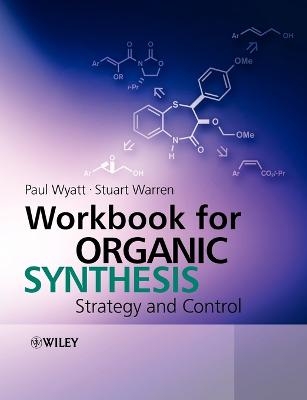
Workbook for Organic Synthesis
John Wiley & Sons Inc (Verlag)
978-0-471-92964-2 (ISBN)
Paul Wyatt
Senior Lecturer and Director of Undergraduate Studies, School of Chemistry, University of Bristol, UK
Stuart Warren
Reader in Organic Chemistry, Department of Chemistry, University of Cambridge, UK.
Workbook for Organic Synthesis: Strategy and Control
This workbook provides a comprehensive graded set of problems to illustrate and develop the themes of each of the chapters in the textbook Organic Synthesis: Strategy and Control. Each problem is followed by a fully explained solution and discussion. The examples extend the student's experience of the types of molecules being synthesised by organic chemists, and the strategies they employ to control their syntheses. By working through these examples students will develop their skills in analysing synthetic challenges, and build a toolkit of strategies for planning new syntheses. Together the workbook and textbook provide a complete course in advanced organic synthesis.
Organic Synthesis: Strategy and Control
Organic Synthesis: Strategy and Control is a sequel to Stuart Warren's bestseller Organic Synthesis: The Disconnection Approach. The 'Disconnection' book concentrated on the planning behind the synthesis of compounds. This book focuses on putting the planning into practice. The two themes of the book are strategy and control: solving problems either by finding an alternative strategy or by controlling any established strategy to make it work.
The book is divided into five sections that deal with selectivity, carbon-carbon single bonds, carbon-carbon double bonds, stereochemistry and functional group strategy. Interpenetrating this structure, the 36 chapters start with classic methods and progress to modern methods and modern strategic considerations. Heterocyclic chemistry is treated throughout the book with full mechanistic explanations as part of organic chemistry rather than a separate entity.
Students and professional chemists familiar with Organic Synthesis: The Disconnection Approach will enjoy the leap into a book designed for chemists at the coalface of organic synthesis.
Dr Paul Wyatt, School of Chemistry, University of Bristol, Bristol Dr Wyatt is Director of Undergraduate Studies for the School of Chemistry at Bristol University and also Director of BRISTOL ChemLabS - a HEFCE Centre for Excellence in Teaching & Learning. Dr Stuart Warren, Department of Chemistry, University of Cambridge, Lensfield Road, Cambridge Dr Warren is the author of the bestselling textbooks Organic Synthesis: The Disconnection Approach (Wiley) and Organic Synthesis (OUP)
Preface vii
A: Introduction: Selectivity 1
1. Planning Organic Syntheses: Tactics, Strategy and Control 3
2. Chemoselectivity 7
3. Regioselectivity: Controlled Aldol Reactions 19
4. Stereoselectivity: Stereoselective Aldol Reactions 35
5. Alternative Strategies for Enone Synthesis 47
6. Choosing a Strategy: The Synthesis of Cyclopentenones 57
B: Making Carbon–Carbon Bonds 69
7. The Ortho Strategy for Aromatic Compounds 71
8. σ-Complexes of Metals 91
9. Controlling the Michael Reaction 103
10. Specific Enol Equivalents 115
11. Extended Enolates 123
12. Allyl Anions 135
13. Homoenolates 147
14. Acyl Anion Equivalents 155
C: Carbon–Carbon Double Bonds 169
15. Synthesis of Double Bonds of Defined Stereochemistry 171
16. Vinyl Anions 191
17. Electrophilic Attack on Alkenes 203
18. Vinyl Cations 221
19. Allyl Alcohols: Allyl Cation Equivalents (and More) 241
D: Stereochemistry 257
20. Control of Stereochemistry–Introduction 259
21. Diastereoselectivity 269
22. Resolution 283
23. The Chiral Pool: Asymmetric Synthesis with Natural Products as Starting Materials 295
24. Asymmetric Induction I: Reagent-Based Strategy 309
25. Asymmetric Induction II: Asymmetric Catalysis: Formation of C–O and C–N Bonds 321
26. Asymmetric Induction III: Asymmetric Catalysis: Formation of C–H and C–C Bonds 335
27. Asymmetric Induction IV: Substrate-Based Strategy 351
28. Kinetic Resolution 365
29. Enzymes: Biological Methods in Asymmetric Synthesis 377
30. New Chiral Centres from Old: Enantiomerically Pure Compounds and Sophisticated Syntheses 391
31. Strategy of Asymmetric Synthesis 405
E: Functional Group Strategy 417
32. Functionalisation of Pyridine 419
33. Oxidation of Aromatic Rings and of Enol(ate)s 433
34. Functionality and Pericyclic Reactions: Nitrogen Heterocycles by Cycloadditions and Sigmatropic Rearrangements 447
35. Synthesis and Chemistry of Azoles and other Heterocycles with Two or more Heteroatoms 459
36. Tandem Organic Reactions 473
Index 483
| Verlagsort | New York |
|---|---|
| Sprache | englisch |
| Maße | 191 x 249 mm |
| Gewicht | 907 g |
| Themenwelt | Naturwissenschaften ► Chemie ► Organische Chemie |
| Naturwissenschaften ► Chemie ► Physikalische Chemie | |
| Schlagworte | Organische Synthese |
| ISBN-10 | 0-471-92964-6 / 0471929646 |
| ISBN-13 | 978-0-471-92964-2 / 9780471929642 |
| Zustand | Neuware |
| Haben Sie eine Frage zum Produkt? |
aus dem Bereich


